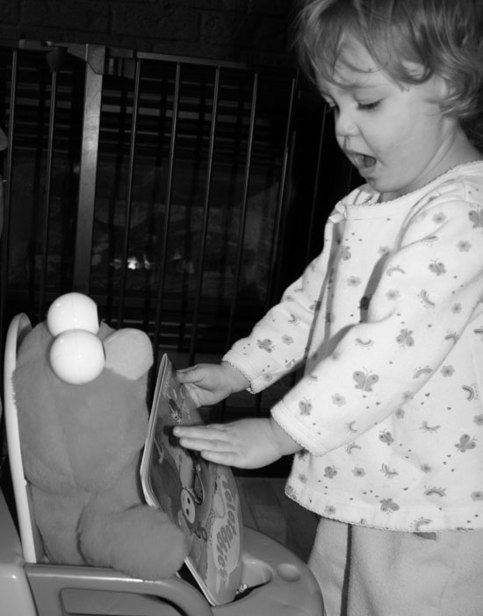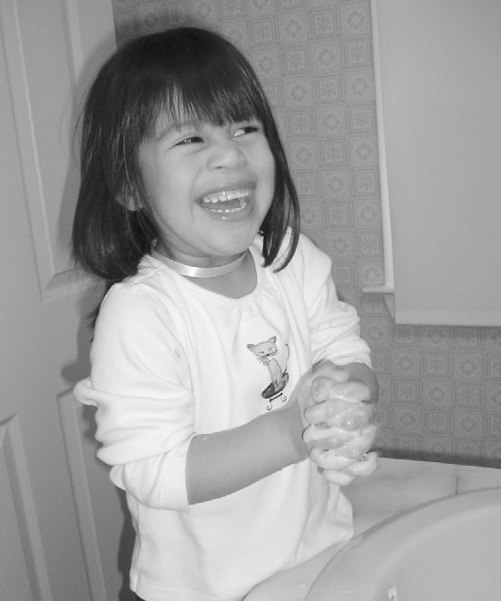The No-cry Potty Training Solution (22 page)
Read The No-cry Potty Training Solution Online
Authors: Elizabeth Pantley

If you’ve ruled out poor wiping skills, potty training resistance, or constipation as reasons for soiling, then talk to your health care provider. There are other reasons that this can occur, and a professional can help you determine what these are for your child.
Common Questions and Sensible Answers
159
Motivating a Child with No Interest in
Potty Training
Our daughter is three and a half years old. We introduced
the potty concept to her almost a year ago when we bought
a Sesame Street potty seat, a drink-and-wet doll, and prizes.
From the beginning, she has loved the idea of putting her
dolly on the potty and then “pretending” to go herself. She
even wipes, flushes, and washes her hands. But not much
really happens! We encourage her with gentle, positive
words, but we’re not making any real progress. She thinks
it is a game. She’s physically ready and able, but, sadly, she
is losing interest in wanting to sit down all that often. Should
we just put it all away and wait until she’s ready?
When potty training is introduced, many children view it as a game—particularly when bright colored potties, dolls, prizes, and playing with water are all part of the event. But how many games will a toddler stay interested in playing many times a day, every day for a year or so? None that I can think of!
In order to help your daughter take potty training seriously, it may be time for you to adjust your view and your approach. Think of it this way: if your daughter lost interest in brushing her teeth, would you just put away her toothbrush until she was ready to use it again?
Of course you wouldn’t—you would brush those little teeth anyway.
Yes, potty training should be relaxed and pleasant, but just like brushing teeth, there is a point when—
happily or not—it just needs to happen.
First, look over the list on page 106 (Chapter 7) to see if you can identify any concrete reasons your child is resisting potty training: is there any trauma, fear, con-

160
The No-Cry Potty Training Solution
Arianna, two years old
fusion, or other issue blocking her? If you can’t come up with anything, then perhaps a change in your attitude will move her along to toileting independence.
Undetected constipation can make elimination
uncomfortable and will stand in the way of toilet training success. Make sure that your child’s diet supports
Common Questions and Sensible Answers
161
easy elimination. Limit sugar, candy, and junk food, and provide plenty of fruit, vegetables, legumes, and whole grains.
Because most young children love to be “big,” you may be able to use this concept to motivate her. Capi-talize on all the benefits of being a big girl, including freedom from diapers and wearing fancy big-kid pants.
On the other hand, some children relish being your
“baby” and fear that if they give up diapers, they must give up other things that they perceive as babyish. If this is the case, let your child know that she can still sit on your lap, be carried, use her pacifier or breastfeed at bedtime, and snuggle with you. Reassure her that saying good-bye to diapers doesn’t mean she has to be all grown up.
Remember to stay positive, and try to be patient.
Your child needs this from you. Eventually she will use the toilet just like everyone else, and this time in your life will just be a blip in your parenting memory book.
So take a big breath and remind yourself that this, too, shall pass.
This is just one small aspect of growing up. There are likely lots of wonderful things happening in your child’s life right now. Try not to let potty training problems color your entire existence. Remember to celebrate all the good things that are happening in your family. Be thankful, and count your blessings.
This page intentionally left blank
9
Bathroom Safety
After years of changing diapers and months of active participation in your child’s potty training process, you are probably looking forward to the day that your child takes over his toileting and becomes independent.
It will indeed be a happy day the first time your child stops play—on his own!—and goes to the bathroom without involving you at all. Such a step in independence does signal a major step in your child’s maturity and is well worth celebrating. However, caution should accompany your celebration. The bathroom can be a very dangerous place for a young child, and even though he’s old enough to handle his own toileting needs, he is years away from having the ability to make his own safety decisions. Furthermore, if your new trainee has younger siblings, they will be exposed to the many hazards that await them when the bathroom door is left open. Most childhood poisoning incidents occur with children between the ages of one and five; three-quarters of these poisonings occur in the home.
Once your child begins toilet training, even before he graduates to going alone, you should make sure you’ve made your bathrooms child-safe. Safety concerns often get missed during the busy potty training process, and they are strangely missing from almost all books on 163

164
The No-Cry Potty Training Solution
Sage, three years old
potty training. But it is time—right now, before another day passes—to do your bathroom safety check.
Keep in mind that safety precautions are updated constantly, and because all children, and all homes, are very different, no checklist is fully complete and appropriate for every situation. However, I’ve worked to make this list as inclusive as possible, and it can help
Bathroom Safety
165
you along as you make all the bathrooms in your home child-safe and ready to welcome your newly independent trainee.
Bathroom Safety Checklist
9 Cover all electrical outlets with child-safe covers.
Install cord protectors.
9 Lower water temperature to a maximum of 120°F
(48.89°C). Teach your child which knob is for
cold water and which is for hot and how to adjust the water temperature before wetting her hands.
9 Store electrical appliances, such as hair dryers, curling irons, and shavers, unplugged and out of reach. Keep electric toothbrush chargers out of reach.
9 Install childproof latches or locks on drawers that contain toiletries, solutions, medications, vita-mins, razors, scissors, and other hazards, or keep them in another room.
9 Put nonskid mats in bathtubs and showers. Cover bathtub faucets with soft protectors.
9 Put nonskid mats under area rugs.
9 Purchase all medications and health products
(such as mouthwash and cold medicine) in child-
proof containers, and keep them locked up or out of reach. Keep in mind that surprisingly young
children can often figure out how to open childproof containers, so keeping them up or locked is important.
9 Use plastic or paper cups and soap holders, not glass.
9 Pay attention to what is put in the bathroom
wastebasket, as curious children are known to
166
The No-Cry Potty Training Solution
explore this container. Razor blades, medications, cleaning supplies, hair color products, and other dangerous items should not be thrown away in the bathroom.
9 Remove the plastic or rubber end caps on
doorstops or replace them with safer one-piece
designs to avoid a choking hazard.
9 Remove any decorative items that could be potential choking hazards.
9 Secure any cabinets, dressers or other freestanding furniture, as they pose a climbing or tipping danger.
9 Install ground-fault circuit interrupters (GFCI or GFI) on outlets. These safety devices are designed to protect from electrical shock. They turn off the current flowing to the plug if there is an electrical problem, such as a wet cord plugged into it. Test your GFIs as often as recommended by the manu-facturer (typically monthly) by pressing a test or reset button.
9 Keep cigarettes, matches, lighters, and ashtrays out of children’s reach.
9 Make sure your child’s potty chair, seat insert, and footstool are securely in place. Keep in mind that these can be used as a climbing device to get your child up to explore higher places.
9 Install metal window safety guards on all upper-floor windows. (Screens do not prevent falling
accidents.)
9 Shorten curtain or blind cords so they are out of reach.
9 Keep a backup key handy in case your child locks herself in the bathroom.




